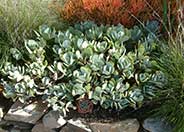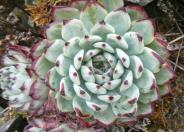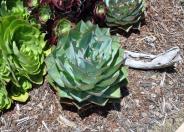
Common name:Silver Jade Plant
Botanical name:Crassula arborescens
This succulent perennial will grow 3-8' tall and has thick, dark green leaves with a tint of pink around the edges. It will do best in partial shade to full sun and dry or moist soil.

Common name:Smooth-edged Agave
Botanical name:Agave weberi
This is a striking medium-sized agave that can grow to 5' tall by 6-10' wide. This agave has very fine marginal teeth, and is sometimes spineless. Supplemental summer watering can prevent yellowing from heat stress in the summer. These plants are also moderately cold hardy, tolerant of temperatures down to 12f. More refined looking than americana. Prone to weevils. Native in Eastern central Mexico. One of the largest of the Agaves.-Mountain States Nursery

Common name:Chalk Fingers
Botanical name:Senecio vitalis
Moderately fast-growing evergreen succulent to 12-18†tall x 3-4’ wide. This attractive species forms a uniform-looking mound of long, narrow, upright-growing bluish-green foliage that makes a wonderful contrast to deeper-colored, broad-leafed shrubs or succulents. Adding further appeal to this popular species are the cream-colored flowers that appear from late-spring to early-summer. Great for beds, borders, or for use in mixed succulent plantings (ground or container). Requires well-drained soil and little water once fully established, and thrives in a sun to light shade exposure.

Common name:Hens and chicks
Botanical name:Echeveria colorata
Echeverias, commonly called “hens and chicks”, are widely appreciated by California gardeners, both as potted plants and as bedding plants. Many of them have neat flower-like rosettes of leaves, and this is certainly true of Echeveria colorata, from the vicinity of Guadalajara in the Mexican state of Jalisco. The thick leaves of E. colorata are white to bluish-white with rosy tips, and in time they will put out a modest number of offsets, though they are not nearly as prolific as some other species such as Echeveria elegans. Typically, the rosettes are about 4 to 5 inches across, but larger forms can approach a foot in diameter. The slender flower stalks of Echeveria colorata emerge around the beginning of March, rising to a height of a foot to a foot and a half and arching over at the tips. The stalk itself is pink, and the outside of the urn-shaped flowers is pink to pinkish-red, with the flared petal tips often grading to yellow-orange. The inside of the flowers is yellow to yellow-orange. At the bud stage, the flowers point downward, but they rotate outward as they open, and then turn upward as they go by, so that the seed capsules develop in an upright position. Echeveria colorata is invariably found growing on rocks in nature, and it makes a great rock-garden specimen. If planted on level ground, a fast-draining mix should be used. This plant looks its best with some direct sun, so that the red in the leaf tips is accentuated and the rosettes remain tight. In hotter inland areas, full sun should be avoided so that the plants do not get scorched during summer hot spells, but under coastal conditions it can take all-day sun. E. colorata can endure temperatures down to the mid-twenties Fahrenheit, but should be protected from anything colder than this.

Common name:Deltoid-leaved Dew Plant
Botanical name:Oscularia deltoides
Oscularia deltoides is a low growing, gray succulent shrublet. This plant is very densely packed, up to 1 foot tall, up to 3 feet wide. It has wiry, dark pink stems and blue-green, 3-angled fleshy leaves that have small, often reddish teeth. In spring into summer appear the small, lightly-fragrant, yellow-centered, lavender-pink flowers that are closed up in the morning but open, often to cover the plant in the afternoon. This succulent does best in full to part sun. In full sun, it will do better with more water, plumping up; with less water, it will look more reddish. If in too much shade, it will not bloom well and less dense. This plant does best in well draining soil and will grow in sand in its native South Africa.

Common name:Echeveria hybrids
Botanical name:Echeveria hybrids
Echeveria hybrids are succulents that has numerous cultivars. This is not a tropical plant. Most have thick, wide leaves and some have ruffled, frilly leaves. Foliage is in rosettes, some tightly coiled and others, loose. They do well in coastal areas and need afternoon shade in warm, inland areas. They like to grow in containers and among rocks and small crevices. They need well draining soil. Leaves come in different colors, thus folks grow them for the foliage more than the flowers which are typically on a thin stalk. Most have offsets, thus easy to propagate. They spread but are typically not invasive.
Designer: Sherman Library and Gardens
Photographer: Anne Chilcott
Physical weed control, including mulching, or hand removal protects the watershed from harmful chemicals.
Develop healthy soil for plants that are vigorous and naturally pest-resistant.